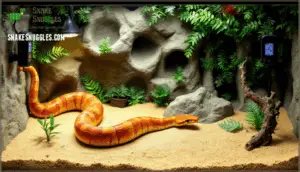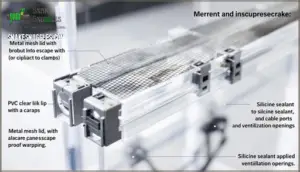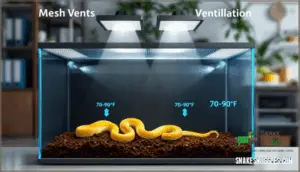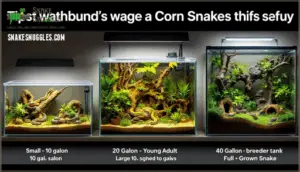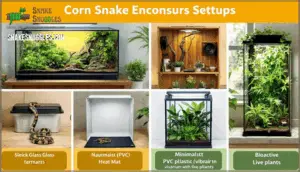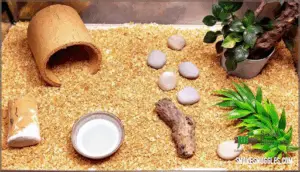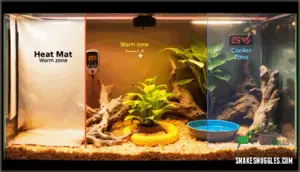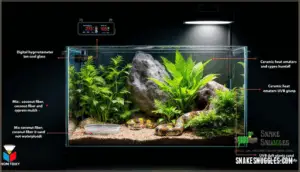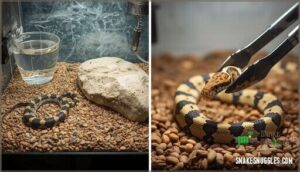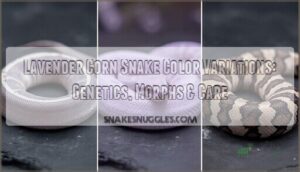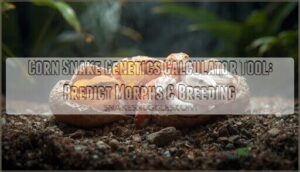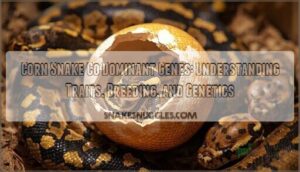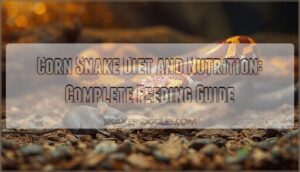This site is supported by our readers. We may earn a commission, at no cost to you, if you purchase through links.
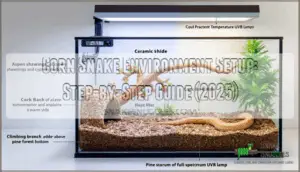
Getting the habitat right from day one means understanding how each component—from substrate depth to thermostat placement—works together to replicate the pine forests and grasslands these colubrids naturally inhabit.
The difference between a surviving snake and a thriving one comes down to precise execution of environmental parameters that support their biology.
Table Of Contents
- Key Takeaways
- Choosing The Right Enclosure
- Selecting Substrate and Environmental Decor
- Establishing Temperature and Heating Zones
- Managing Humidity and Lighting
- Routine Maintenance and Safe Feeding Practices
- Frequently Asked Questions (FAQs)
- How do you set up a corn snake habitat?
- Do corn snakes need a proper habitat?
- Do corn snakes need an enclosure?
- How do I set up a corn snake enclosure?
- How do you maintain a corn snake bioactive enclosure?
- How do I set up a corn snake tank?
- How often should water bowls be cleaned?
- Can corn snakes cohabitate with other snakes?
- What signs indicate stress in corn snakes?
- How do you handle a corn snake safely?
- Conclusion
Key Takeaways
- Your corn snake’s first shed quality directly reveals whether your enclosure setup is working—a clean, one-piece shed means you’ve correctly balanced humidity (40-60%), temperature gradients (75-90°F), and hiding spots, while patchy sheds expose gaps in environmental design.
- Enclosure size must match your snake’s life stage, starting with 10 gallons for hatchlings and scaling to a minimum 40-gallon tank (36" × 18" × 18") for adults, since restricted space increases stress by 40% and limits natural foraging behaviors.
- Creating a proper thermal gradient with distinct warm (85-90°F) and cool (75-82°F) zones, plus a focused basking spot at 88-92°F, allows your snake to thermoregulate naturally—always pair heat sources with proportional thermostats to maintain accuracy within ±1°F.
- Substrate depth of 3-4 inches using moisture-retentive materials like cypress mulch or organic topsoil mix supports natural burrowing behavior and humidity control, while daily spot-cleaning and full substrate replacement every 3-4 months prevents bacterial buildup and respiratory issues.
Choosing The Right Enclosure
Getting your corn snake’s home right starts with the enclosure itself. You’ll need to think through size, security, and airflow before you even add substrate or heat.
Let’s break down what makes an enclosure work for these escape artists.
Minimum Tank Size Requirements
Your corn snake needs room to stretch, explore, and thrive. A 40-gallon tank (36" × 18" × 18") meets the minimum for adults, though research shows larger spaces—48" × 24" × 24"—improve behavioral health.
- Hatchling enclosures: Start with 10 gallons, then upgrade as they grow
- Adult dimensions: Match enclosure length to your snake’s full body length (3–5 feet)
- Behavioral impacts: Restricted space increases stress by 40% and reduces natural foraging
To help reduce stress, provide a secure hiding place. Proper space utilization prevents stereotypic pacing and fosters a 20-year lifespan.
Secure Lid and Escape-Proof Design
Once you’ve chosen the right size, you need a rock-solid containment system. Corn snakes can squeeze through gaps as small as 6 mm, so locking mechanisms—like metal mesh lids with four clamps or front-door latches—are non-negotiable. Seal cable ports with silicone, keep ventilation openings under 4 mm, and inspect seals weekly.
Corn snakes squeeze through 6mm gaps, so use locking lids with four clamps, seal all ports with silicone, and inspect weekly
Material integrity matters: PVC panels resist warping better than glass. Selecting appropriate enclosure materials is important for reptile well-being. These inspection practices prevent 70% of escapes.
Proper Ventilation and Airflow
Airtight security won’t help if stale air and mold growth take hold. Your corn snake needs 8–12 full air changes daily to prevent respiratory infections and bacterial buildup.
Position mesh vents at both the top and bottom—hot air exits upward while cool air enters below. This convection flow maintains your 70–90°F gradient without desiccating humidity zones.
Avoid side-screen designs; they create cross-breezes that disrupt temperature layers and stress your snake.
Enclosure Size for Hatchlings Vs. Adults
Once ventilation is sorted, you’ll need to match enclosure size to your snake’s growth stage—hatchlings and adults won’t thrive in the same setup.
Hatchling Security (8–12 inches): Start with a 10-gallon tank (20″L × 10″W × 12″H). Oversized spaces stress young snakes and trigger feeding refusals.
Juvenile Exploration (12–36 inches): Upgrade to a 20–30-gallon long enclosure around 30″L × 12″W × 12″H as they double in length within their first year.
Adult Activity (3–5 feet): Adults require minimum 40-gallon breeders (36″L × 18″W × 18″H), though 48″L × 24″W × 24″H setups improve welfare and climbing behavior.
Match enclosure length to your corn snake’s full body length—shorter spaces limit movement and reduce enrichment interaction.
Types of Enclosures for Corn Snakes
Material choice determines your corn snake enclosure setup success—each type offers distinct trade-offs in heat retention, durability, and ease of use.
| Enclosure Type | Key Benefits | Primary Drawbacks |
|---|---|---|
| Glass enclosures | High visibility, easy cleaning, affordable ($50–$150) | Glass drawbacks include 40% faster heat loss, fragile construction, heavy weight (45+ lb) |
| Wooden enclosures | Wooden benefits include 25–35% better insulation, customizable layouts, natural aesthetics | Requires waterproof sealing, heavier than PVC (30–55 lb), higher upfront cost |
| Plastic (PVC) enclosures | PVC safety through non-porous surfaces, lightweight (under 25 lb), 20% lower heating costs | Low-quality PVC warps above 100°F, limited ventilation in budget models |
| Bioactive setup | Self-cleaning waste processing, natural humidity control (45–55%), behavioral enrichment | Requires 4–6 months stabilization, higher initial investment, complex maintenance |
Hybrid advantages combine glass visibility with wood or PVC insulation, reducing heat loss by 15–30% while supporting precise thermal gradients from 75–92°F across your corn snake’s activity zones.
Selecting Substrate and Environmental Decor
Once you’ve got your enclosure sorted, the next step is choosing what goes inside. Your substrate and decor aren’t just about looks—they directly affect your corn snake’s health, comfort, and natural behavior.
Here’s what you need to know to set things up right.
Best Substrate Options and Depth
Your substrate choice acts like a foundation for your snake’s entire environment. You’ll want to aim for 3–4 inches of depth to promote natural burrowing and maintain stable humidity levels between 65–75%.
Here are your top substrate options:
- Organic topsoil mix: Combine 40% topsoil, 30–40% peat moss, 20% sand, and 10% clay—this mimics native habitat and encourages tunneling
- Cypress mulch: Retains moisture 50% longer than aspen shavings, making humidity control easier
- Bioactive soil with cleanup crew: Adds isopods and springtails to reduce full replacements, cutting waste by 60%
Spot-clean daily and replace substrate every 3–4 months to prevent bacterial buildup.
Solid Vs. Loose Substrate Pros and Cons
When choosing between solid and loose substrate options, you’ll need to weigh cleaning ease against behavioral enrichment. Solid substrates like paper towels offer fast replacement—under 2 minutes—and precise health monitoring, making them ideal for quarantine. However, they don’t encourage burrowing behavior or humidity control.
Loose substrates, such as coconut fiber at 3–4 inch depth, foster natural tunneling and maintain 40–75% humidity but carry impaction risk if husbandry falters. Dusty bedding materials can compromise respiratory health, while proper substrate depth with quality loose options reduces stress and backs species-appropriate activity.
Adding Natural Decor and Climbing Structures
Think of natural decor as your snake’s personal jungle gym—enrichment studies show corn snakes housed with climbing structures increase visible activity by over 30%. You’ll want at least two climbing branches with rough bark, since corn snakes push up to nine times their body weight against surfaces for grip. Choose hardwood like oak or maple with bark thickness over 5 mm for best traction and material selection safety. Secure each branch with three anchor points to prevent falls, and inspect for splinters before placement.
Artificial vines and nontoxic plants work well for environmental enrichment, with 75% of snakes actively using them for natural behavior expression. Rearrange your decor arrangement every 2–4 weeks—this simple enrichment frequency boosts exploratory activity by 35% and aids hiding spots and climbing structures that reduce stress indicators.
Creating Hides and Moist Retreats
Your snake won’t thrive without proper hiding spots—studies show enclosures with multiple hides cut stress responses by over 80%. You’ll need at least two hides for hide placement importance, one on each temperature zone, plus a humidity hide for shedding problem prevention.
Here’s your setup checklist:
- Place one opaque hide on the warm side and one on the cool side for stress reduction benefits
- Add a humid hide with moist sphagnum moss to maintain 75–85% moisture retention during sheds
- Size each hide so your snake touches the sides when coiled—oversized hiding spots get ignored
- Use hide material safety options like smooth plastic, cork bark, or terracotta with no sharp edges
Replace humid hide alternatives substrate weekly to prevent mold, and your snake will use these spaces up to 80% of the time.
Integrating Live or Artificial Plants
Plants do more than fill empty space—they actually boost your snake’s activity by 30–40% while stabilizing humidity levels naturally. You’ll get better results with hardy live options like pothos or Boston fern for humidity impact and behavioral enrichment, but artificial plants work if your snake’s too active.
For bioactive setups, secure live nontoxic plants in substrate grooves to prevent uprooting, and add climbing branches through dense foliage—this creates hides and environmental enrichment your snake will use daily.
Clean artificial plants biweekly with reptile-safe disinfectant for plant safety, since they don’t provide the humidity impact or pathogen control that live plants offer through transpiration and root aeration.
Establishing Temperature and Heating Zones
Your corn snake won’t thrive without the right heat setup, so you need to understand how temperature zones work. Think of it like building a miniature climate with distinct warm and cool areas your snake can move between.
Let’s break down exactly how to create and maintain these essential thermal zones.
Creating a Thermal Gradient
With proper heating and temperature control, you create an essential environment where your snake can move freely between zones. This behavioral thermoregulation mimics natural conditions and fosters metabolic efficiency.
- Gradient layout places heat sources on one-third of the enclosure, leaving two-thirds cooler
- Gradient technologies like ceramic emitters and heat mats maintain the thermal gradient from 24°C to 32°C
- Thermostat use keeps temperature variance within ±0.5°C for consistent control
- Monitoring practices require twice-daily checks to detect deviations beyond ±1°C
- Physiological outcomes include faster growth rates and improved feeding response when gradients are optimized correctly
Warm Side, Cool Side, and Basking Area Temps
After setting up the gradient zones, you need exact temperature targets at each location. Your warm side should stay between 85°F and 90°F for proper digestion, while the cool side ranges from 75°F to 82°F for thermoregulation.
Position basking lamps to create a focused hotspot at 88–92°F directly beneath. Night drops to around 75°F suit adults well, but hatchlings need steadier warmth near 85°F.
Use digital probes for temperature monitoring at substrate level on both ends.
Heat Source Options and Thermostat Use
Once you’ve pinpointed your temperature zones, you’ll need reliable heating equipment paired with precise control. Your options break down into three main categories:
- Heat bulbs and basking lamps – Dual overhead bulbs create a focused 88–92°F hotspot while distributing infrared-A and -B radiation efficiently for thermoregulation
- Ceramic heat emitters (CHE) – These provide stable ambient warming without visible light, ideal for maintaining gradients overnight with 92% adoption among keepers
- Heat mats – Under-tank heating works as a secondary source for warm hides, reaching 85–90°F at substrate level
Every heat source requires thermostat pairing to prevent overheating incidents. Proportional (dimming) thermostats regulate basking bulbs and projectors within ±1°F, extending projector lifespan by 30% compared to on/off models.
Mount your thermostat probe on the enclosure wall near the warm zone—not where your snake can contact it directly—to maintain accurate temperature gradient control. Heat bulb safety demands ceramic sockets and external lamp placement, eliminating burn risks entirely.
Nighttime Temperature Adjustments
Your thermostat controls daytime heat, but nighttime temperature drops are just as important for your corn snake’s circadian rhythm and natural cooling benefits. Let ambient temps fall to 70–75°F—some keepers go as low as 65°F if room conditions allow.
Turn off visible-light heat sources completely. If your space dips below 70°F, switch to a ceramic heat emitter or low-wattage heat mat to preserve the temperature gradient without disrupting rest, always monitoring stability with dual-probe thermometers for ideal heat retention.
Monitoring and Maintaining Temperatures
How often should you verify those readings? Check your digital thermometer twice daily—morning and evening—to catch any drift before it stresses your snake. Place one probe on the basking surface and another midway through the thermal gradient.
Recalibrate your thermostat monthly, adjust heat wattage for seasonal shifts, and insulate the enclosure to lock in temperature stability, preventing the heating cycle from overworking.
Managing Humidity and Lighting
You’ve nailed the temperature zones, but your corn snake’s health also depends on getting moisture and light just right.
Humidity affects shedding quality and respiratory function, while proper lighting keeps your snake’s internal clock on track.
Let’s walk through the specific tools and techniques you’ll need to dial in both parameters.
Ideal Humidity Range and Monitoring Tools
Maintaining the ideal humidity range between 40% and 60% prevents shedding complications and respiratory infections in your corn snake. Ambient humidity in your home contributes 30–40% of enclosure moisture, but factors like ventilation and heat sources can lower levels by 10–20%.
Use a digital hygrometer with ±2% accuracy for reliable humidity monitoring—place the probe mid-enclosure to capture representative readings. Check humidity levels twice daily, morning and evening, to track diurnal variation. Verify your hygrometer monthly using a saturated salt solution to ensure measurements stay within ±3% accuracy.
Misting, Moisture Retention, and Humid Hides
Beyond baseline humidity readings, your corn snake benefits from targeted Moisture Control through daily misting and specialized microhabitats. Implement these humidity control methods for effective Shedding Support:
- Mist substrate and enclosure walls each morning using a pressure sprayer for even moisture distribution
- Maintain at least 3 inches of moisture-retentive Substrate Types like coconut fiber or cypress mulch
- Create a Humid Hide by lining a hide box with damp sphagnum moss, placed on the warm side
- Increase misting frequency and raise humidity to 70% when your snake enters its pre-shed "blue" phase
This layered approach to moisture retention maintains your ideal humidity range while supporting complete ecdysis.
Preventing Excess Moisture and Mold
While humidity control aids healthy shedding, excess moisture creates a breeding ground for mold growth. Proper ventilation can cut mold risk by 60%. Position vents near both warm and cool zones to improve airflow.
Replace damp moss in humid hides biweekly, and choose fast-drying substrate selection like a 40% topsoil, 40% ReptiSoil, and 20% sand blend.
Bioactive benefits include natural mold suppression through cleanup crews, while weekly spot cleaning schedules prevent spore buildup before it starts.
Types of Lighting Fixtures
Lighting fixtures act like separate tools in your toolkit—each one has a different purpose. Full-spectrum LED grow lights at 6000–6500 K support circadian rhythm regulation and boost LED efficiency by cutting energy use up to 60%. For UVB lighting, T5 HO fluorescent tubes deliver UVI values of 2.0–3.0 at proper UVB intensity. Heat lamps using 50–75 W halogen bulbs create basking zones through infrared radiation.
Timer automation maintains consistent 12-hour light cycles without manual effort, while the lighting spectrum you choose affects both plant health and your snake’s natural behavior.
UVB Lighting and Proper Light Cycle Duration
UVB lighting is essential for raising vitamin D3 levels from 57 nmol/L to 196 nmol/L, which supports calcium metabolism and prevents metabolic bone disease. A 22-inch T5 HO 5.0 or 6% bulb should be positioned 10–12 inches above the basking area to achieve a UVI of 2.0–3.0. The light cycle should run for 12 hours daily, adjusting to 13 hours in summer and 11 in winter.
- UVB benefits: Promotes circadian rhythm, hormonal function, and natural behavior patterns
- Bulb specifications: Replace tubes every 12 months when UVB spectrum output declines below effective levels
- Light duration: Automated timers prevent inconsistent cycles that suppress appetite and reduce activity by 38%
- Enclosure integration: Position fixtures across two-thirds of enclosure length, allowing gradient exposure for self-regulation
Aluminum reflector hoods enhance light intensity efficiency by 50%, ensuring uniform UVB distribution across basking zones.
Routine Maintenance and Safe Feeding Practices
Keeping your corn snake healthy means staying on top of routine cleaning and sticking to a proper feeding schedule. You’ll need to balance daily maintenance tasks with less frequent deep cleans, all while making sure your snake gets the right food at the right time.
Here’s what you need to know about maintaining the enclosure and feeding your corn snake safely.
Daily Spot Cleaning and Water Changes
You’ll want to remove waste daily—feces, urates, and shed skin—to prevent ammonia buildup that can irritate your snake’s respiratory system. This daily spot cleaning takes about five to ten minutes and stops bacterial growth before it starts.
Change your water bowl every day or two to maintain water quality and avoid biofilm. During shedding, swap it more often to support hydration and humidity.
Use reptile-safe cleaning products or diluted bleach solutions on surfaces, and always wash your hands before and after to follow proper hygiene standards and reduce disease risks.
Deep Cleaning Frequency and Safe Products
Beyond daily tasks, you’ll need a full deep cleaning every four to six weeks. This means removing your snake temporarily, scrubbing all surfaces, and replacing substrate entirely.
Use reptile-safe cleaners like F10SC or Zoo Med Wipe Out—these disinfectants knock out harmful bacteria and fungi without leaving toxic residue.
Avoid ammonia-based or phenol products; they’re dangerous for your snake’s respiratory health and can cause chemical burns.
Disinfecting Procedures and Substrate Replacement
After choosing reptile-safe cleaners, you’ll need proper disinfecting procedures. Mix a 0.15% bleach concentration for surfaces—contact time matters, so let it sit for at least 15 minutes before rinsing thoroughly.
Scoop waste removal daily to prevent ammonia buildup. Replace all substrate every three to four months, maintaining a substrate depth of 3–4 inches for burrowing.
Don’t forget tool sterilization: soak scrapers and tongs in disinfectant for five minutes after cleaning.
Setting Up Feeding Areas
Once disinfecting is complete, proper feeding areas prevent contamination. Use separate enclosures like dedicated feeding tubs—these reduce substrate ingestion by 90% and help your snake distinguish mealtime from handling.
Equip them with 10-inch feeding tools to safely present frozen-thawed prey warmed to 98–100°F. Remove uneaten rodents within 30 minutes, then disinfect the feeding environment.
Always provide fresh water bowl access, and allow 48–72 hours post-feeding care before any handling to prevent regurgitation.
Feeding Schedules for Hatchlings and Adults
Hatchlings need consistent feeding—every 5–7 days with frozen-thawed prey measuring 1–1.5x their body width. Juveniles advance to 7–10-day intervals as they grow, while adults thrive on 14–21-day schedules.
Temperature impact matters: warm enclosures (85–90°F) speed digestion, reducing regurgitation risk. Oversized prey size increases complications by 35%, so match nutritional needs carefully to avoid metabolic stress in all life stages.
Frequently Asked Questions (FAQs)
How do you set up a corn snake habitat?
A well-designed setup is worth its weight in gold. You’ll need habitat essentials like a secure enclosure (at least 48" x 24" x 24" for adults), proper substrate options and choices, heating temperature gradient zones, and humidity control methods to guarantee snake safety and enrichment ideas.
Do corn snakes need a proper habitat?
Yes, corn snakes absolutely need a proper habitat. Without correct enclosure size, thermal gradients, and humidity control, they face serious health implications including respiratory infections and shedding problems.
Proper corn snake habitat design promotes behavioral enrichment and meets ethical considerations for captive care.
Do corn snakes need an enclosure?
Without a secure enclosure, your corn snake can’t regulate body temperature, maintain proper humidity, or express natural behaviors—safety concerns and health implications make it essential.
Minimum tank size requirements prevent stress, supporting behavioral impacts that determine long-term wellness. Snake enclosure necessity isn’t optional; it’s fundamental.
How do I set up a corn snake enclosure?
Setting up a proper enclosure involves layering substrate at 3-4 inches depth and placing hides on both heating temperature gradient zones.
Additionally, installing heat sources with thermostats is crucial, as is maintaining humidity levels between 40-60% using moisture-retentive materials and monitoring tools.
How do you maintain a corn snake bioactive enclosure?
A bioactive setup is like a living garden—it needs balance, not control.
Maintain humidity between 40-60%, spot-clean waste weekly, and mist substrate as needed.
Let your cleanup crew of springtails and isopods handle decomposition, creating a self-sustaining ecosystem with healthy microfauna and thriving plants.
How do I set up a corn snake tank?
You’ll need at least a 40-gallon tank with a secure lid for adults, while hatchlings start in 10-20 gallons.
Add 3-4 inches of substrate like cypress mulch, create a thermal gradient from 70-75°F cool side to 85-90°F warm side, and maintain 40-60% humidity control.
How often should water bowls be cleaned?
Think of stagnant water as a petri dish—bacterial growth and contamination risks escalate rapidly.
Clean your snake’s water bowl every 1-2 days, or daily during shedding when soaking increases hygiene demands and mold growth potential.
Can corn snakes cohabitate with other snakes?
No, corn snakes shouldn’t cohabitate with other snakes. Their solitary nature makes them prone to stress behaviors, cannibalism risks, and disease transmission.
Resource competition can trigger aggression, and shared reptile habitats increase health dangers despite proper snake care protocols.
What signs indicate stress in corn snakes?
Behavioral changes include increased hiding, defensive strikes, rapid tongue flicking, and feeding refusal. Physical symptoms such as incomplete sheds, elevated respiration, and weight loss are also observed.
Environmental stressors, like incorrect temperatures, worsen health issues, requiring immediate reptile care adjustments.
How do you handle a corn snake safely?
Support your snake’s body with both hands, using gentle movements. Watch for stress signals like hissing or tight coiling, and limit handling to 10-15 minutes.
Practice proper hand hygiene before and after each session.
Conclusion
A botched shed isn’t just cosmetic—it’s your snake waving a red flag about survival conditions you thought were adequate.
When your corn snake environment setup delivers consistent temperature gradients, precise humidity control, and species-appropriate hiding zones, that translucent skin will confirm you’ve replicated the environmental triggers evolution hardwired into their physiology.
Every thermostat reading and substrate choice either bolsters their biological needs or creates stress that accumulates silently until health problems surface.
- https://www.reddit.com/r/reptiles/comments/10o5118/is_it_too_cold_for_my_corn_snake/
- https://reptifiles.com/corn-snake-care-guide/corn-snake-temperatures-humidity/
- https://www.visionproducts.us/blog/corn-snakes/
- https://www.rspca.org.uk/adviceandwelfare/pets/other/cornsnake
- https://internetreptile.com/blogs/care-sheets/corn-snake-care-sheet

